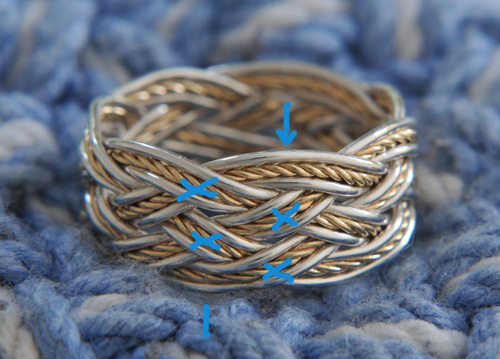Decorative Marlingspike Seamanship rendered in precious metal.
| Information Center | Shop Around For Goodies |
|
This page should give you some idea of what goes into pricing rings. At its simplest, you can multiply the number of crossings from the chart below by $40 for gold, ($55 for 24K), $60 for platinum, $15 for silver, $15 for stainless steel. Exotic metals that are more work, but less costly, may differ from these price points, and market forces may move them up or down. Read on, for a more detailed explanation:
Look at this image, of a five lead ring with seven loops or bights around the edge. |
|||||||||||||||||||||||||||||||||||||||||||||

|
|||||||||||||||||||||||||||||||||||||||||||||
|
There are seven loops on each side of the ring, and each loop has two crossings associated with it. Thus, this ring has 7x2+7x2, or 28 crossings in total. Its cost would be 28 times whichever factor applies, shown above.
The chart below shows the number of crossings in several Turk's-head knots that can be used as rings. Its main utility is in demonstrating why (and by how much) a more complex knot is relatively more expensive than a simple one. Ring prices are dependent upon the complexity of the knot and the cost of materials. The "crossings" are the places where the paths cross in the knot, and I use the number as a fairly accurate assessment of the amount of work that I actually invest in any given ring. Your cost for a ring would be calculated by using the number below, multiplied by a factor based on labor and cost of materials, mentioned previously The choices shown here are either rings that I have actually made, at least in prototype, or items that I anticipate being able to produce without significant delay, as I have already made the tools required. Click on the available links to see some of the ones that already exist. My pricing methods may be perceived as complex, and I apologize to those for whom it is merely a confusing distraction. Experience has shown me that there are some combinations which are not likely to succeed, even though it may be possible to actually tie the knot. For this reason I have added a "Size" column to the table, showing either the minimum and maximum sizes, or the minimum size, for the particular knot desired. The number of loops around the edge should fall in the range of 3.5 to 4.5 loops/inch. See this page for further discusion of size and pattern selection. |
|||||||||||||||||||||||||||||||||||||||||||||
|
|||||||||||||||||||||||||||||||||||||||||||||
| Note that the examples linked above are strictly to indicate the appearance of the knot itself, and use of different materials will not substantially alter the structure, just the colors. | |||||||||||||||||||||||||||||||||||||||||||||
|
It is possible to tie multi-line knots as well as single-line knots, but I have not listed the possibilities in the table. Here's an example of a two-line ring, and a three-line ring, made with a different color gold for each part. Prices on request.
|
|||||||||||||||||||||||||||||||||||||||||||||
|
Earrings and chains - please call or email me for prices.
|
(This site last updated on 12-12-2020)
©1997-2019 Loren Damewood All Rights Reserved
|
